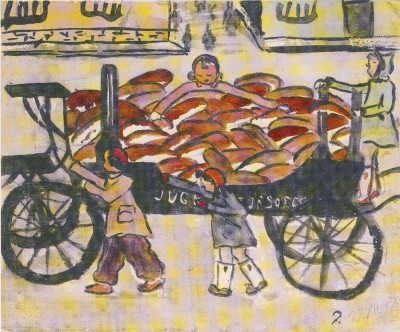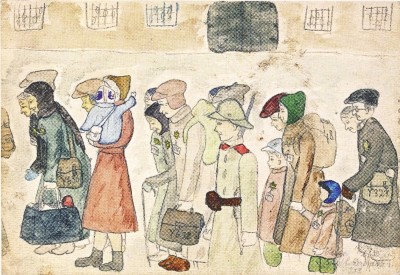Helga Hošková - Weissová (*1929)
Persecution of the Jewish inhabitants of the Protectorate of Bohemia and Moravia started with its establishment in March 1939. Helga was then 9 years old. The individual anti-Jewish measures gradually came to affect her as well. The young perceptive girl just began writing her own diary, committing to it all her feelings, thoughts and opinions...
In December 1941 she and her parents were put on a transport codenamed “L“ going to the Terezín Ghetto. Helga took a diary along with her and more than that: as she loved drawing since her childhood, she packed crayons, watercolors and a sketchbook into her knapsack. She and her mother were placed in the so-called Dresden Barracks (for women inmates), father lived in the Sudeten Barracks for male prisoners. In the early days of the Ghetto there was a strict ban on leaving the barracks and meeting other inmates. Yet (just as many others) the Weiss family violated the ban on several occasions and Helga also sent to her father a picture as a keepsake – daddy responded with an important message: “Paint what you see!”. As a result, in addition to her diary, she got down to work on a second original record portraying the life of a 12-year old girl in the Ghetto, namely dozens of pictures capturing what were frequently quite drastic scenes...
According to her diary, the first children’s homes (“heims“) were set up during the winter of 1941/1942 and gradually moved into special buildings. That was why Helga was separated from her mother in the summer of 1942 and moved to a children’s home in the square codenamed L 410 (room No. 24). In her free time she continued writing entries into her diary and secretly drawing pictures. The diary and her drawings offer a vivid mosaic of the Ghetto’s captive community. Its describes efforts of the Ghetto inmates to live a semblance of a “normal” life in the heims (celebrating feasts, reading books, singing, organizing clandestine lessons, rehearsing or watching theater performances) that were accompanied by everyday traumatic experiences: fear of being separated from one’s family, fear of transports to the East, fear of diseases, persistent hunger etc.
A landmark in the life of the Weiss family came in the fall of 1944 with the wave of transports from Terezín to the East, to Auschwitz. Assigned to the first – allegedly labor camp transport – was Helga´s father who urged his wife and daughter never to volunteer for any transport whatsoever. However, when a new transport was announced several days later and the relatives of those who had already left Terezín were invited to report for the new transport, Helga and her mother did volunteer. Just as their father and husband, the two women arrived in the Auschwitz-Birkenau extermination camp. But unlike him they passed the selection and were assigned to work. They stayed in Auschwitz for only a couple of days and were soon deported to Freiberg near Dresden, working in an aircraft-manufacturing factory. In the middle of April 1945 they were sent in a death transport to the Mauthausen concentration camp. Conditions in the transport were shocking, prisoners were crammed in open wagons, without food. Since World War II was already drawing to its end, their train was delayed on its journey through Bohemia. The prisoners arrived in Mauthausen one day after its gas chambers had been destroyed…
After the liberation Helga and her mother returned to Prague at the end of May 1945. They met Helga´s uncle Josef Polák who had just been liberated in the Terezín Ghetto. Before her transport to the East Helga had given him her drawings and diary to hide in Terezín. Thanks to her uncle the drawings and her diary had been saved and duly returned to Helga.
After the war Helga continued to devote herself to drawing, she later passed her school-leaving exam at a grammar school and at the State School of Graphic Art. She studied at the College of Applied Arts in a studio led by Professors Emil Filla and Alois Fišárek. She sometimes harked back to her wartime experience and also illustrated books by Arnošt Lustig. Her life was positively influenced by her visit to Israel in the mid-1960s where she stayed in an art colony for ten weeks and also traveled throughout the country. At that time her drawings for the first time featured brighter colors even though her gloomy recollections of her youth and her lost relatives were still reflected in her art.
In 1991 she created a commemorative plaque for the assembly point at the former Radio Market in Prague’s Holešovice district where people had gathered before deportation to Terezín during the war. Together with other former inmates of the Terezín Ghetto she often visited Terezín, taking part in the debates held during the Terezín Memorial’s workshops, discussions with pupils and students as well as their teachers.
Her drawings were published in 1998 in a book called “Zeichne, was Du siehst“ (“Draw What You See”), her “Diary 1938 – 1945” appeared in 2012.


